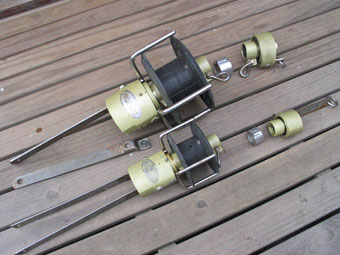
This page is provided to assist others who may find themselves, as I did, with a furler for which parts are no longer available from Profurl. The information may also be of use if needing in an emergency to field-install spare bearings and seals obtained from Profurl or elsewhere. Any comments from other Profurl users (or indeed from Profurl) on these procedures are welcome. (see my home page for contact details)

Starship’s main working headsail is a high cut genoa, with a padded luff, on an N42 Profurl furler. The staysail is on a smaller N31 Profurl. Both furlers were purchased new in 1988 from Profurl’s Australian agent, and worked reliably throughout our circumnavigation. In 2003, after a period of disuse I discovered the furling drums and the halyard carriers on both units had become very difficult to rotate by hand. Evidently moisture had got past the seals and was rusting the bearings (and as it turned out, the seal shells).
Profurl no longer offered spares for the N31 which had been discontinued in 1992. The N42 was superseded, although I was told spare bearings and seals for the current model NC42 would suit. However the Australian Profurl agents, who I’ve always found very helpful, advised that if the anodised aluminium surfaces against which the N42 seals rotate had been damaged I would just be wasting money having Profurl replace the seals and bearings - the new seals would be unable to keep the water out for long. So I was faced with one and perhaps two furlers that were at the end of their working life. The spars themselves still seem in good condition. Even having Profurl dismantle the N42 only to advise that it was not worth repairing would have involved couriers and other expenses. So with nothing much to lose I decided to dismantle them both to see if the N42 was indeed damaged, and whether it was possible to replace the bearings myself.
Dismantling proved quite
straight forward, making notes and taking depth dimensions with a Vernier caliper as I proceeded to
ensure that I could reassemble things in their correct location. First the seals had to be
speared with a screwdriver and levered out,
taking care not to damage the housings. The units were then cleaned with
kerosene and a brush to remove remaining grease. The grease appeared
similar to the milky yellow grease used in sheet winches - there was still
plenty of it but obviously water contaminated. This exposed the first of several strong
steel internal and external circlips - the first used to set the depth to which the
seals could be pressed on assembly, and others to locate the bearings on the
central spindles (which are hollow to take the furling spar) or retain the
bearing within the housings. The N31 assemblies also included a thin aluminium
ring, the only function of which seemed to be to prevent one of the circlips
being inserted too far, from where it might be difficult to reposition
correctly. Extracting the numerous circlips from the very confined and deep
annular recess between the housing and spar carrier proved the only difficult
part of the job.
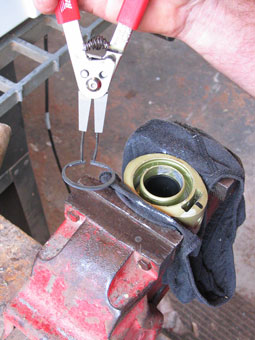 My
reversible (can be used for internal and external circlips) Repco
circlip pliers were not really up to the job, their tips being much
smaller than the holes in the circlips, allowing the clips to twist and then
slip off the tip. In several instances I eventually had to insert thin stainless
shims to prevent the circlips slipping back into their grooves and then drag the circlips out spirally using a wire
loop passed through one of the holes. Circlips
are standard engineering components, so I could probably have bought
replacements, but fortunately these proved malleable enough to be bent back to
their correct shape and re-used.
My
reversible (can be used for internal and external circlips) Repco
circlip pliers were not really up to the job, their tips being much
smaller than the holes in the circlips, allowing the clips to twist and then
slip off the tip. In several instances I eventually had to insert thin stainless
shims to prevent the circlips slipping back into their grooves and then drag the circlips out spirally using a wire
loop passed through one of the holes. Circlips
are standard engineering components, so I could probably have bought
replacements, but fortunately these proved malleable enough to be bent back to
their correct shape and re-used.
After removal of circlips I used a hammer and various suitable short sections of aluminium tube to carefully drive the bearings out, and later to tap in the new components. They were not very tight fits, but during re-assembly the tubes should bear on whichever race (inner or outer) is being forced in or on at the time..
The photo below shows the components for the N31 halyard carrier, but although they look physically different the carriers and drums are very similar internally, each containing a single standard deep groove carbon steel ball bearing, grease lubricated, and protected either side with a standard nitrile rubber double lip oil seal with sprung skirts and steel shells. The nitrile cases were heavily degraded, but not apparently by sunlight because the lower seals were in a similar state. The encased steel shells were heavily rusted, which is hardly surprising after 15 years. Profurl claim their current seals have stainless steel inserted shells. The drum and carrier used the same size bearings and seals, and the seal dimensions and bearing # were stamped or moulded into each component.
The anodizing had indeed worn
through on parts of the sealing surfaces of both furlers, but since the bearings
had not actually
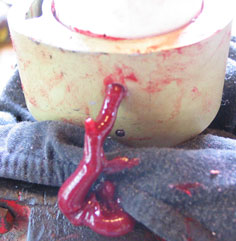 collapsed
the marks were smooth and shallow, and would probably seal satisfactorily for
sometime yet, especially in conjunction with fresh grease. More significant were a couple of scratches
caused in extracting the circlips, which I smoothed out as best I could with a
very fine emery stone.
collapsed
the marks were smooth and shallow, and would probably seal satisfactorily for
sometime yet, especially in conjunction with fresh grease. More significant were a couple of scratches
caused in extracting the circlips, which I smoothed out as best I could with a
very fine emery stone.
The units had originally been grease filled, and two small stainless steel pins blanked off holes in each housing. These holes had presumably allowed excess grease to escape as the final seal was forced into the housing. I drilled and tapped new holes with 6mm internal threads directly opposite each pin. After assembling with new bearings and seals with copious "wheel bearing" grease, the excess was forced out through these holes. I then blanked them off with 6mm machine screws. My intention is to periodically fit grease nipples into one of these threads and force fresh grease through the bearing and out the other hole, in the hope that this will at least delay moisture reaching them. Unfortunately the seals are not positively retained in the housing, so using these holes to force old grease back through the seals would probably just expel the seals.
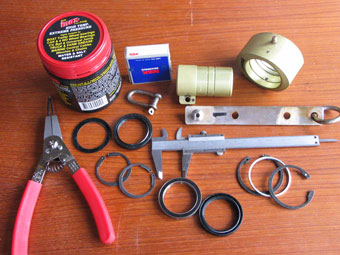 Total
cost of bearings, seals, grease, machine screws, and grease
nipples for the two units was under Au$200. I feel this is a reasonable cost
for extending their lives, even if only by a couple of years.
Total
cost of bearings, seals, grease, machine screws, and grease
nipples for the two units was under Au$200. I feel this is a reasonable cost
for extending their lives, even if only by a couple of years.
N31 bearings – 52x40x7mm deep groove - NSK #6808 or equivalent
N31 Oil seals – 52x40x7mm standard nitrile rubber double lip
N42 Bearings – 80x50x10mm deep groove - NSK #16010 or equivalent -
N42 Oil Seals – 80x50x13mm – standard nitrile rubber double lip. 13mm wide seals are listed in seal catalogues but were not available from my local supplier, so I replaced them using 80x50x8mm seals plus a 5mm spacer ring (to position them correctly). The ring was made by cutting a 5mm wide strip from 1.5mm aluminium sheet, and bending it to fit neatly inside the housing. This also had the effect of locating the sealing point on a less worn part of the spindle. Another option would be to use a second seal - 5mm thick. Seals with stainless steel shells inside the rubber are also listed in catalogues, but the only stocks I could locate were with wholesalers in the USA who had a minimum order of 50 seals.
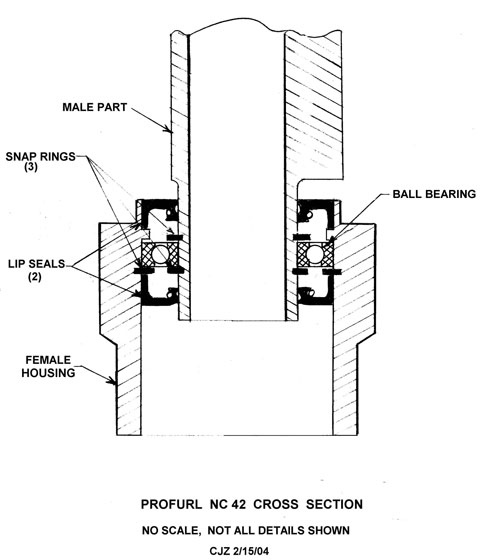
Having read this web page, several sailors have contacted me over the last couple of years for further information, and one also introduced me to Chris Zinger on the cruising yacht "Amulet." , who had made some similar repairs. Chris has given me a copy of his very detailed instructions, and while he doesn't want them published on the Internet I have his permission to pass them on to other owners of N42 Profurls who request them, for their private use only. Above is a sketch by Chris, showing the cross section of the lower bearing (inside the drum). The swivel is similar. Chris terms the circlips as "snap-rings". However do take note, as Chris warns - the sketch doesn't show all details - for example there was an additional circlip inside my units which limited the depth to which the lower seal could be pressed. I suspect the lower housing at least had originally been designed to contain two identical ball bearings, but Profurl had found in practice the skew loads could be handled by just one.